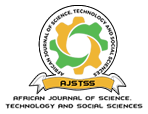Utilization of Bamboo Biochar as an adsorbent in the removal of heavy metals from wastewater stabilization ponds effluent in Embu Town, Kenya
DOI:
https://doi.org/10.58506/ajstss.v3i2.234Keywords:
wastewater, lead, cadmium, copper, bamboo, biochar, stabilization pondsAbstract
Rapid population growth and expansion of industries have led to increase in the presence of heavy metals in wastewater. Irregular discharge of such wastewater with little or no treatment has been rampant in developing countries. Exposure to heavy metals has been associated with stunted growth and development, acute and chronic respiratory effects, cancerous effects, autoimmunity and even death. Technological solutions for heavy metal removal that are affordable, environmentally benign, and simple to use are needed to address these challenges. This study investigated the effectiveness of two differently modified bamboo biochar’s in removal of selected heavy metals from wastewater stabilization ponds (WSPs) effluent in Embu town, Kenya. One modification involved pyrolysis hourly at 250°C, then at 350°C, and lastly at 500°C and labelled AC whereas the other involved chemical activation using potassium hydroxide followed by pyrolysis and referred as AC+KOH. Sampling of wastewater along the treatment processes was conducted during the wet and dry season, totalling to forty-two samples. Atomic absorption spectrophotometer was used to analyse the amounts of Pb2+, Cd2+, and Cu2+ ions in the WSPs effluents. Mean concentrations ranged from 0 to 0.355 ppm, 0.002 ppm, and 0.035 ppm during the wet season and 0 to 0.018 ppm, 0.004 ppm, and 0.097 ppm respectively during the dry season. The maximum National Environmental Management Authority, 2006, allowable limits for discharge into public water for Pb2+, Cd2+, and Cu2+ ions are 0.01 ppm, 0.01 ppm, and 1 ppm respectively. Microsoft Excel, SPSS version 26 and R studio was used for statistical analysis. The lead removal effectiveness of treating polluted effluents with the AC ranged from 86% to 100%, whereas treatments using AC+KOH ranged between 72% to 90%. There was a significant difference, the p-value was 0.04655 < 0.05 between the differently modified bamboo biochar’s. Findings from the study indicates effectiveness of bamboo biochar in treating wastewater contaminated with heavy metal (Pb2+) with AC performing better than AC+KOH.


